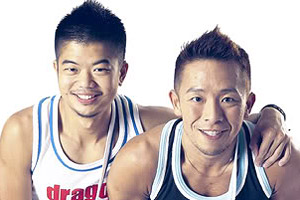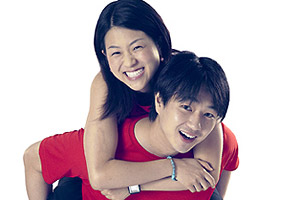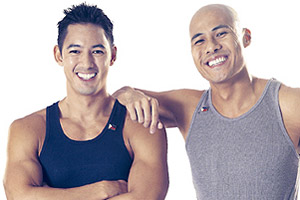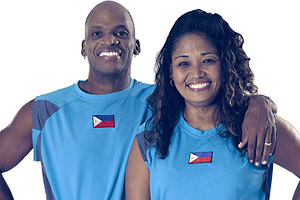Season 2
The Amazing Race Asia is an Asian reality competition series based on the American version created by Elise Doganieri and Bertram van Munster, in which teams of two race around the world against other teams, with the first-place team winning $100,000.
The series premiered on AXN Asia on 9 November, 2006 and is hosted by Chinese-American actor Allan Wu.
The Amazing Race Asia premiered in South Africa on DStv's Sony Entertainment Television (SONY) channel on Wednesday 15 April 2009, at 19h00. See "Seasons" below for seasonal broadcast dates and times.
Season 2 aired on SONY from 3 January - 28 March, 2010, on Sundays at 19h45. New episodes broadcast weekly. There are 13 episodes in the second season.
Season 2 Repeats
Mondays: 03h30, 14h00
Season 2
The Amazing Race Asia returns for Season 2, which sees the teams touch down in Cape Town during their final two legs.
This second season ups the ante with both ten diverse teams and new, challenges designed to push wits and relationships to breaking point.
Host Allan Wu returns to guide viewers through each leg as these adventurous racers, made up of siblings, best friends, couples and ex-flatmates, go all-out around the clock to bag the $100,000 prize.
Assembling in Singapore, the teams jet off to a wide range of countries including the Philippines, China, New Zealand, Japan, South Korea, Germany, the Czech Republic and South Africa, where they race through Khayelitsha, the Aquila Park game reserve, District Six and the Victoria & Alfred Waterfront.
Season 2 Teams
Adrian Yap and Collin Low
Gym Buddies from Singapore

Young, energetic and passionate about their fitness regime, gym buddies, Collin and Adrian from Singapore are in such good shape that they could be the perfect poster boys for being fit and healthy.
In fact, one can hardly tell that this team holds a secret which can prove to either be a setback or a huge advantage in The Amazing Race Asia.
Ann Tan and Diane Douglas
Dancing Mums from Malaysia

You can call them the desperate housewives of Malaysia - housewives who are desperate for new challenges and adventure, that is. And what better way to discover excitement than to pack their bags and take off on The Amazing Race Asia.
These two longtime dancing buddies are trying to prove that after family commitments, everything else they undertake should be as easy as performing hip hop or funk jazz.
Brett Money and Kinaryosih
Dating Two Years from Jakarta, Indonesia

Good looking does not even scratch the surface when it comes to describing the glamorous Brett and Kinaryosih. Sure, her excuse is that she is a rising actress with several TV shows and movies under her belt, but with him, he looks like anything but your everyday physiotherapist.
First impressions aside, will this beautiful duo dazzle audiences or outshine the competition, or do both?
Daichi Kawashima and Sawaka Kawashima
Brother/Sister from Tokyo, Japan

For the first time, Japan joins the cast of The Amazing Race Asia and offers up a new element to the race. Siblings Sawaka and Daichi have only recently reunited after a family misunderstanding that happened three years ago.
Will the race offer them a chance to re-discover the family love they once shared, or will they buckle under the pressure of their strained family ties?
Edwin Lo and Monica Lo
Dating Ten Years from Hong Kong

Drama has always been the spice that drives the lives of this team. Monica is an actress who knows the subject all too well in her day job, while Edwin has been nicknamed "Drama King" by his friends.
Both also look to drum up the drama in this race, by calling themselves to be the Rob and Amber (from the US version) of this race.
Paula Taylor and Natasha Monks
Childhood Friends from Thailand

One works as a VJ in Bangkok, Thailand, and is a rising, hot starlet, having appeared in several Thai movies since 2002. The other is more than likely a sight for sore eyes at the mining company where she works at, dealing with, well, explosives.
What Paula Taylor and Natasha Monks have in common, besides turning 24 this year and in possession of sizzling good looks, is a lifetime of friendship and the intent to win The Amazing Race Asia.
Rovilson Fernandez and Marc Nelson
Best Buddies from Philippines

No Amazing Race show can be without its hunk factor and that is where Marc and Rovilson from the Philippines come in. This is one team with the two flamboyant individuals, who dish out a mixture of comedy and ego with a ton of sass.
Both TV hosts by day, Rovilson also works as a magazine editor while Marc is a model, whose face, and rather well toned body, has graced the cover of many magazines.
Sophie Teng and Aurelia Chenat
Ex-Housemates from Hong Kong

Both in the prime of their life, Hong Kong residents, Sophie and Aurelia are attractive, outgoing, and personable but any other noticeable similarities stop here as both cannot be as different as night and day when it comes to their personalities.
Trinidad "Terri" Reed and Henry Reed
Married 13 Years from Philippines

When it comes to the discipline, dedication and effort placed in getting things done, nothing prepares you quite like the military and after over 20 years of serving his country, retired United States Navy Senior Chief Petty Officer Henry Reed, together with his wife, Terri, is taking all he knows about traveling around the world and putting them into competing in The Amazing Race Asia.
Vanessa Chong and Pamela Chong
Sisters from Malaysia

When it comes to The Amazing Race Asia, there is an unspoken pressure for Pamela, 24, and Vanessa, 29, to bring home the top prize.
Yes, both Malaysians realize that there is a lot riding on them to perform well, since the winners of the inaugural The Amazing Race Asia were Malaysian and also an all female team.
Format
10 Teams from all over Asia join host Allan Wu to get the usual introduction before grabbing their packs and getting on their way.
Each of ten teams on The Amazing Race Asia is composed of two individuals who have a pre-existing. The participants are all required to be able to communicate in English.
The contestants chosen to appear are from various Asian countries and not limited to one country of origin. Participating countries include all citizens of the continent of Asia except the Middle East as well as non-Asian workers who are living in Asia for a long period of time.
From Season 2 onwards, Japanese residents are able to participate, having been ineligible for Season 1.
At the beginning of each leg of the race, each team receives an allowance of cash with their first clue, with the cash usually in U.S. dollars. Any money left over after a leg of the race can be used on subsequent legs.
The exception to this is the purchase of airline tickets, which the teams pay for using a credit card supplied to them by the show.
In The Amazing Race Asia, the route markers are also coloured yellow and red with the exception in the second leg of Season 3, when the route markers were coloured yellow and white to avoid confusion with the flag of South Vietnam.
For the Asian edition, teams do not depart immediately from starting city. Instead, they remain in the starting city during the first leg entirely (Season 1) or in part (Seasons 2 and 3) depending on the clues.
All route information and clues in The Amazing Race Asia are adopted from the original American version. Season 2 introduces the Intersection marker, while Season 3 introduces the U-Turn marker. Generally, both formats are similar, but a few differences still can be seen in the race.
Like in the Roadblock, teams can generally perform the task without a time limit; however, if the tasks require the teams to form a queue, generally the clues will state that teams must perform within a predefined amount of time.
If a team fails to do the task within the time limit, that team will lose their turn and will be required to let the next team try.
The structure of the race is similar in both versions of the show. The teams travel to different locations by following the route information, performing some various tasks, and checking in at the Pit Stop.
Teams normally complete all tasks and check in at the Pit Stop before they are eliminated. Occasionally, on an elimination leg, if all other teams have checked in and the last team is very far behind, Route Markers may instruct them to go directly to the Pit Stop without completing the rest of the leg.
Exceptions implemented in The Amazing Race Asia are: the teams unable to get to the next Route Marker because they have to do some task to earn it while all other teams already checked in or the location of a task is closed beyond the hours of operation.
In this case, teams will be led by the production staff to the Pit Stop and be eliminated by Wu or Wu himself coming out to the team's current location to announce their elimination there.
In some legs, the first teams to arrive win prizes, usually from the show's sponsors. Season 3 is the first season to award prizes in every leg of the Race.
The clue which directs a team to the Finish Line mentions it not as such but as a "Final Pit Stop." Instead of having an elevated red carpet with The Amazing Race logo enlarged on it as is used in the American edition, the Finish Line consists only of a regular check-in mat for the final three teams.
Each race has a number of predetermined non-elimination legs, in which the last team to arrive at the Pit Stop is not eliminated and is allowed to continue on the race.
Most of the rules and penalties are adopted directly from the American edition; but in some of cases, the Asian version has been seen to have a unique set of additional rules.
Each team will sign a confidential agreement preventing themselves from revealing the details of the Race before airing. Teams will be fined with five million U.S. dollars if the contract is breached.
If a team member is injured during the race, he/she has to pass medical evaluation to ensure they are fit to continue the race.
In the American edition, if the injury is not serious or life-threatening, the team may choose to continue or quit the race. This occurred to Marshall & Lance during Season 5. Margie suffered heatstroke at the end Leg 7 in Season 14 and their team was allowed to continue.
Teams must follow local road laws and regulations and be responsible to pay any fines and demerits they incur during the race.
If teams violate speeding laws, the number of minutes for the time penalty is the amount of speed in kilometers per hour that the team traveled minus the legal speed limit then multiplied by two minutes.
However, this penalty is only served at the beginning of the next leg of the race, and causes criticisms from among the teams (see criticisms). While speeding is also against the rules in the American version (as shown in Season 2 and Season 13), the penalty is not given in a measurement of time additional miles per hour over the speed limit but rather of time gained plus an additional 30 minutes.
In the American edition, the teams who quit a Roadblock must serve a four-hour penalty assessed starting from when the next team arrives at the task site, whereas in the Asian edition, this four-hour penalty applies at the Pit Stop prior to checking in and not at the Roadblock itself.
Hitchhiking (travelling in privately owned vehicles) is prohibited; if a team violates this rule, they incur a one hour penalty. In the American version, a hitchhiking team generally does not incur a time penalty. But if the clue says that the team must take an appropriate form of transportation, they are asked to go back and take it as directed.
Winners
Season 1: Zabrina Fernandez and Joe Jer Tee
Season 2: Adrian Yap and Collin Low
Seasons
The series airs exclusively on SONY
Season 1 (13 episodes)
Premiere: 15 April 2009 | Finale: 8 July 2009 | Wednesdays, 19h00
Season 2 (13 episodes)
Premiere: 3 January 2010 | Finale: 28 March 2010 | Sundays, 19h45
Season 3 (11 episodes)
Premiere: 15 August 2010 | Finale: 24 October 2010 | Sundays, 19h45